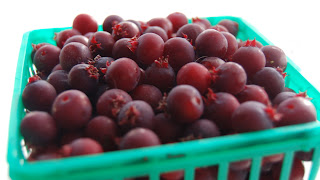In permaculture, the edge of habitats is extremely important to consider. It is on the edges of an ecological system that it's connection to another ecological system is merged and blurred. It is at the edge where the most diversity is found. It's always amazing how much food is ripening on our edges. Not just at the farm or in our gardens, but outside the farm and on the edges of our gardens and yards. A few days ago my wife, Alyssa and I were walking down the Stanton Ave. in Garfield not looking for anything, just walking toward one of our favorite restaurants for brunch. It was our anniversary and we were on vacation from our kids. While walking down the hill we spotted a small street tree full of bright pink berries. We immediately knew they were edible Juneberries, also called Allegheny Serviceberries. I picked a couple and continued on to see another and another tree full of berries. In all there were about twenty trees, all ready for the picking. And they were being picked, by the birds. Later in the week my staff from Garfield Farm harvested about ten quarts from just one or two of the trees for our CSA. Those berries are food for anyone who wants to pick it. It's example of just how easy it is to grow good, nutritious food that supports biodiversity. In our design work the edge of our created ecological gardens are always considered, how it connects with our neighbor's yard, the park next to our home, and the needs and offerings of our whole neighborhood. Through intelligently designed permaculture systems greater support of our collective edge habitats can become healthier and more integrated, supporting more food production for the masses and more habitat for native wildlife.



Comments
Post a Comment